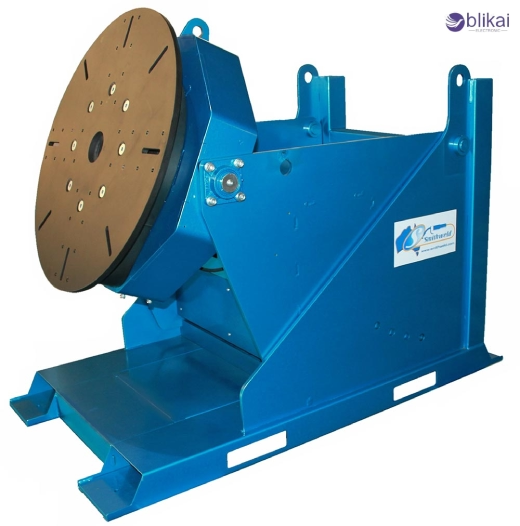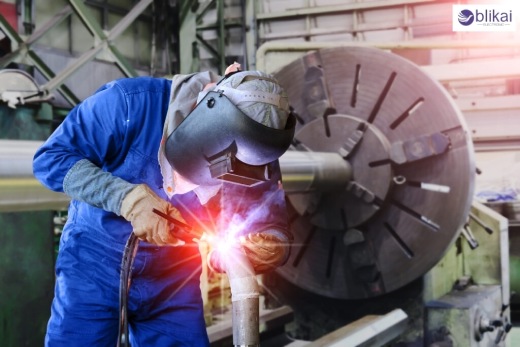Welding Positioner Controls & Electronic Components Guide
Introduction
In modern days, metal fabricators must rely on automation because it’s never an optional step. A positioner is an important machine that helps achieve good welds by spinning or tilting the workpiece to its ideal position. Essential to this tool is a control system built from chosen electronic components. All of these components combine to make sure welding is accurate, quick and easy to manage.

What Is a Welding Positioner?
The purpose of a welding positioner is to move or tilt a workpiece so the welder can weld at the best angle without having to move the workpiece by hand. It leads to more work being accomplished, a safer environment and better consistency of both welds and their appearance.
Types of Welding Positioner Controls
The way a positioner is controlled dramatically affects usability and integration with other systems. The main types include:
1. Manual Controls
The simplest form uses foot pedals or switches to control movement.
2. Foot Pedal Controls
Provide variable speed and directional control, often preferred in TIG setups for dynamic control.
3. PLC-Controlled Systems
Programmable logic controllers allow for repeatable, automated movement—ideal for high-volume production.
4. Remote-Controlled Systems
Wireless or wired controllers offer flexibility, especially in hard-to-reach areas or rotating environments.
Key Electronic Components in Welding Positioners
A welding positioner is essentially an electromechanical system. Its brain (controller) and nerves (electrical components) determine how effectively it functions. Below are the critical parts:
1. Motors
DC Motors: Common for low-voltage, simple systems.
AC Motors: Suitable for industrial-grade setups.
Stepper Motors: Provide precise angle control.
Servo Motors: Ideal for automated, high-precision welding.
2. Motor Drivers & Controllers
These regulate the voltage, current, and movement logic of the motor.
3. Rotary Encoders & Position Sensors
Provide feedback to the control system, enabling accurate movement and stopping.
4. Relays & Contactors
Switch high-power circuits using low-voltage control signals.
5. Solid-State Relays (SSR)
Quieter, faster, and longer-lasting than mechanical relays used in high-speed control.
6. Power Supply Units (PSUs)
Convert AC to DC and stabilize voltage for sensitive components.
7. Speed Controllers & Potentiometers
Allow manual adjustment of motor rotation speed.
How the Control System Works
Welding positioners follow a straightforward yet powerful logic flow:
1. Input from the operator or automated system (e.g., foot pedal, PLC)
2. Processing in the controller that interprets direction, speed, and angle
3. Power delivery from motor drivers to the motor
4. Feedback from sensors or encoders to confirm position and adjust motion
A feedback loop allows precise control—which is crucial for automated or robotic welding systems. Some systems also synchronize the rotation with the welding arc to maintain consistent weld speeds.
Wiring and Installation Tips
Proper wiring ensures both safety and functionality:
Safety Tips:
- Always ground the positioner chassis.
- Use shielded cables for encoder or sensor wiring to avoid EMI.
- Disconnect power before servicing.
Wiring Best Practices:
- Use labeled connectors and color-coded wires.
- Follow manufacturer diagrams for motor and driver connections.
- Keep power and signal cables separate to prevent interference.
Pro Tip: Use slip rings or rotary connectors to allow continuous rotation without cable tangling.
Welding Positioner Applications
Pipe and Tube Welding
Using positioners is typical in pipe and tube fabrication. Using a jig enables the welder to make uniform welds, raising the joint quality while decreasing defects. Thanks to rotation, positioners allow for 1G or flat position welding, which is far less complicated and time-consuming than other methods.
Structural Steel and Heavy Fabrication
In heavy fabrication, including construction and shipbuilding, large and heavy parts are handled by welding positioners. Editing is possible without needing cranes or manual moves, helping to reduce time and increase safety. They help allow welders to reach difficult positions and angles with less difficulty.
Automotive and Aerospace Industries
Higher accuracy in welding is needed in autos and aircraft assembly. Positioners are important for assembling frames, exhaust parts and structural parts. They make it possible to produce the same weld over and over again and control its direction, which matters a lot when high quality is required.
Pressure Vessels and Tank Fabrication
Many pressure vessel, tank and cylinder manufacturers depend on welding positioners. Having circular seams is necessary for many of these materials and rotating positioners make the process more efficient and create a better result. If automation is handy, it becomes even easier to produce food and drinks in large batches.
Robotic and Automated Welding Systems
Welding positioners are integral to robotic welding setups. They synchronize with robotic arms to maintain the correct torch angle and workpiece orientation. This improves efficiency, reduces cycle time, and minimizes human error in automated welding processes.
Repair and Maintenance Applications
Repair workshops and maintenance yards rely on positioners to renew worn parts or add special material coverings. They can reach damage points without pulling apart complicated systems, meaning time and labor are saved.
Small Part and Precision Welding
Bench-top machines offer the proper control and stable environment for handling small components such as gears, brackets or valves. They are often chosen for precision welding operations, such as TIG welding because a precise location is required.

Welding Positioner Advantages
Increased Welding Efficiency
Rotation and tilting made possible by welding positioners raise productivity and help the welder focus better. As a result, welders do not need to adjust their hand positions or reposition either the part or the robot as often, so work can be done faster.
Improved Weld Quality
Having a consistent positioner for welding makes it easier for welders to keep their hands steady and control the process well. Because of this, welders are left with stronger welds, showing even beads and less chance of undercuts or porosity.
Enhanced Safety
Picking up and working with difficult shapes can be dangerous for people. By using a positioner, much of the tough lifting and moving is eliminated, reducing the chance of an accident and ensuring the job is safer for the staff.
Greater Operator Comfort
With positioners, the welder can rest the work at a comfortable position and angle, which relieves their body stress. This benefit matters most during long welding jobs, helping prevent tiredness and ensuring that welders keep their aim.
Versatility Across Applications
You can use welding positioners with MIG, TIG and arc welding. Their ability to shape different-sized and shaped objects means they are useful in the automotive, aerospace, oil and gas and structural steel industries.
Cost Savings Over Time
Even though there is an upfront expense, using welding positioners often reduces spending in the long run by requiring less labor, helping assembly lines move faster and reducing rework caused by welding errors. The result is higher efficiency and better profits in manufacturing.
Troubleshooting Common Issues
1. Positioner Not Rotating
Check the power supply and fuse.
Inspect motor driver signals.
2. Overheating Motor
This could be due to overloading or incorrect driver configuration.
3. Inaccurate Positioning
Check encoder alignment or sensor malfunction.
4. Signal Noise
Use shielded cables and ferrite cores to reduce electromagnetic interference.
Having a multimeter and motor tester on hand can help diagnose most issues quickly.
Choosing the Right Components
Matching your components to the workload is critical. Here’s what to consider:
- Motor Torque: Ensure it can handle the weight of the workpiece.
- Voltage Compatibility: Match with available shop power (e.g., 110V, 220V, 24V DC).
- Durability: Use industrial-rated components for harsh welding environments.
- Integration: Ensure compatibility with your welder’s control outputs or automation system.
Upgrading or Customizing a Welding Positioner
For advanced automation or production line integration, consider these upgrades:
1. Add a PLC or Microcontroller
Enables programmable sequences, delays, and external device synchronization.
2. Remote or Wireless Control
RF modules or Bluetooth systems allow operator flexibility.
3. Human-Machine Interface (HMI)
Touchscreens provide intuitive setup and control.
4. IoT Integration
Real-time monitoring and logging for smart manufacturing setups.
Conclusion
Modern fabrication places great importance on the controls and electronics of welding positioners. If you’re starting fresh or updating your equipment, using this knowledge will help your equipment work more reliably, accurately and safely.
FAQ
Q: Can I retrofit a manual positioner with a motor and controller?
A: Yes, there are plenty of kits and ready-made motors that make retrofitting possible. Do proper load and safety checking before using the structure.
Q: Is a PLC necessary for small workshops?
A: Sometimes, that is not the case. If you only need a small output, a system with a potentiometer is fine, but PLCs give automation and reliability to more advanced users.
Q: What type of motor is best for welding positioners?
A: Servo motors are designed for precision, but AC motors are made for intense and heavy jobs. Pick the product according to how much torque you require and how much control you desire.
FPGA vs ASIC: Which one should you Choose?
LMC555CN Timer: Applications, Features, and Datasheet
Cr2 vs Cr123: Which Battery Is Right for You? [Explained]
What is an Induction Motor :All You Need to Know
RG213 vs LMR400:Which is Your Best Choice
What is a Piezoelectric Transducer?Features, Specification and Applications
556 Timer Circuits: Features, Specification and Applications
Comparison of ESP8266 Modules: ESP-01, ESP-05, ESP-12, ESP-201
XCF32PFSG48C Configuration Memory: Applications, Features, and Datasheet
74ACT818SPC:Description,Features,Application and FAQ










